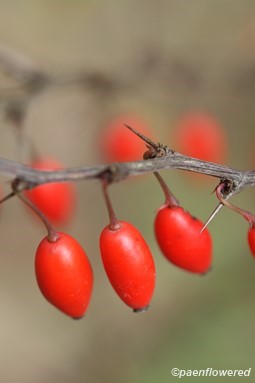Berberis thunbergii
This ornamental plant has become highly invasive and established in the woods all over the state
Berberis thunbergii Japanese barberry
It is native to Japan and was brought to the United States as an ornamental and hedge plant, but escaped cultivation. It is now an invasive plant in the northeastern United States. It is a dense deciduous shrub that grows 2-8 feet tall. It flowers in April and May in the northeast and the fruit forms from July to October. The branches are smooth and deeply grooved. The spines occur singly along the branches. The leaves are spatula-shaped or narrowly oval and are 0.5 to 1.5 inches long. The color of the leaves can vary from slightly bluish-green to green to dark reddish-purple. The flowers occur in clusters and hang down from the branches. The berries are slightly juicy, but solid and hang on the stem until the following spring. Ground birds like turkey and grouse as well as small mammals disperse the seeds as they feed on the fruit. The plant can also spread by growing roots where branches come in contact with the soil. It is shade tolerant and forms dense strands in habitats that vary from closed-canopy forests, wetlands, pastures, meadows, and waste areas. The related common barberry (B. vulgaris) is also non-native, but less invasive. It has leaves with small teeth.
Habitat & Range
Grows along forest edges, in forests, meadows, fields, and man-disturbed habitats.
Present throughout the state.
| EMP: | FACU |
|---|---|
| NCNE: | FACU |
Phenology
Flowers April through May.
Fruit forms from July to October.









Comments
Have you spotted this plant in your area? We'd love to hear about your experience! Share your comments or questions about the plant below. Comments are moderated before posting.